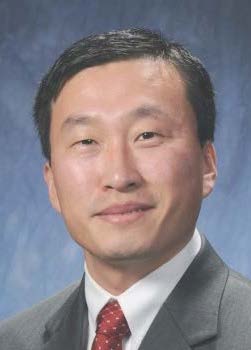Dr. Yugang Sun [Dept. of Chemistry, Temple University, USA]
Title: Hot-Electron Generation in “Quantum-Sized” Platinum Nanocrystals
Time: 2:00 - 3:00 PM, Tuesday, July 4, 2017
Place: Conference Room 410, HPSTAR (Shanghai)
Host: Dr. Lin Wang
Abstract
Platinum (Pt) nanocrystals are commonly used in chemical reactions because of their unusual catalytic activity, for example, photocatalytic water splitting of water. In a typical design, Pt nanocrystals can accept photo-excited electrons from light absorbers such as semiconductor quantum dots (QDs) to catalyze hydrogen evolution reaction (HER) [1]. Charge transfer from QDs to Pt nanocrystals is very inefficient, and shuttle molecules (e.g., methyl viologen) or other shuttle species are necessary to facilitate the charge transfer [2]. In addition to receiving energetic electrons from semiconductor QDs, Pt nanocrystal can also absorb visible light to generate energetic electrons (or hot electrons), which can directly reduce reactive species or migrate across a metal/semiconductor Schottky barrier to the conduction band of a semiconductor. Different from the widely studied plasmonic metal nanocrystals (e.g., Au, Ag), the efficiency of generating hot electrons in the weakly absorbing Pt nanocrystals is very low. We found that depositing Pt nanocrystals on spherical glass beads (i.e., SiO2 particles) could significantly enhance the visible absorption coefficient of the Pt nanocrystals. For example, in SiO2@Pt nanocrystals@TiO2 core-shell nanostructures, the enhancement in visible absorption enables the efficient generation of energetic electrons in photoexcited Pt nanocrystals, which can easily transfer to the TiO2 surface layer to drive HER and many other chemical reactions [3].
References
(1)Rasamani, K. D.; Li, Z.; Sun, Y. Nanoscale2016, 8, 18621-18625.
(2)Hu, Y.; Liu, Y.; Sun, Y. Adv. Funct. Mater.2015, 25, 1638-1647.
(3)Zhang, N.; Han, C.; Xu, Y.-J.; Foley, J. J., IV; Zhang, D.; Codrington, J.; Gray, S. K.; Sun, Y. Nat. Photon.2016, 10, 473-482.
Biography of the Speaker

Dr. Yugang Sun obtained his B.S and Ph.D degree from University of Science and Technology of China (USTC) in 1996 and 2001, respectively. He then worked as a postdoctoral fellow with Prof. Younan Xia at the University of Washington and Prof. John A. Rogers at the University of Illinois at Urbana-Champaign. In 2006, Dr. Sun joined the Center for Nanoscale Materials at Argonne National Laboratory (ANL) to start his independent research career. He moved to Chemistry Department of Temple University in January 2016. He received the Presidential Early Career Award for Scientists and Engineers (PECASE) in 2007 and DOE’s Office of Science Early Career Scientist and Engineering Award in 2008. His work has a significant impact the field of nanomaterials, and he was listed in the top 100 chemists (#62) and top 100 Materials scientists (#5) analyzed by Thomson Reuters in 2011. His research is centered in the design/synthesis of hybrid nanostructures as well as investigation of novel properties of the synthesized nanostructures in the context of nanophotonics, photocatalysis, sensing, and energy storage/conversion.
